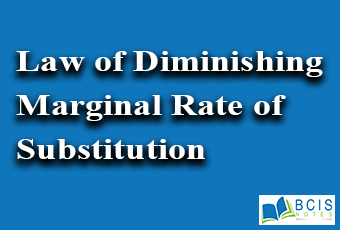
The Law of Diminishing Marginal Rate of Substitution (MRS)
Marginal Rate of Substitution is the rate at which units of two goods ate substituted each other to maintain the same level of satisfaction. The concept of the marginal rate of substitution is an important tool for the indifference curve analysis of demand. The Law of Diminishing Marginal Rate of Substitution (MRS) is the rate at which units of goods are exchanged to each other to maintain the same level of satisfaction. In other words, the MRS of X for Y represents the amount of Y which the consumer has to give up for the gain of the same additional units of X so that his level of satisfaction remains the same.

The marginal rate of substitution of X and Y (MRSxy) is defined as the amount of Y, the consumer is just willing to give up to get one more unit of X and maintain the same level of satisfaction.
MRSxy = (Decrease in the consumption of Y)÷(Increase in the consumption of X )
Indifference Map: The Indifference Map is the graphical representation of two or more indifference curves showing the several combinations of different quantities of commodities, which consumer consumes, given his income and the market price of goods and services. The consumer preferences give rise to several combinations of commodities, each yielding the same level of satisfaction. A higher indifference curve yields higher level of satisfaction than the lower one. It is because higher IC contains more units of two goods or more units of at least one good than the lower one. Hence, the IC map reflects an ordering or ranking of the individual’s preferences.
| Combinations-1 |
X |
Y | Combinations-2 | X | Y |
|
A |
1 | 16 | F | 2 | 20 |
|
B |
2 | 12 | G | 3 |
16 |
| C | 3 | 9 | H | 4 |
13 |
|
D |
4 | 7 | I | 5 | 11 |
| E | 5 | 6 | J | 6 |
10 |
Causes for the Operation of Law of Diminishing Marginal Rate of Substitution
1. Causes in Intensity of Wants: One of the characteristics of human wants is that the want for a particular good is stable at a time. As the consumer has more and more of a good, the intensity of his wants for that good goes or declining. It is because of this fall in the intensity of the want for the good, say X, that when it’s stock increase with the consumer, he is prepared to forego less and less of good Y for every increment in X.
2. Imperfect Substitution: Secondly, MRS declines due to the fact that the two goods are imperfect substitutes of each other. Goods are imperfect substitutes for each other. If two goods are perfect substitutes of each other then they are regarded as one and the same good, and therefore increase in the quantity of one and decrease in the quantity of the other would not make any difference in the marginal sacrifice of the goods.
3. Assumption of MRS: Thirdly, MRS diminishes also because of the fact that the increase in the quantity of one good does not increase the want satisfying power of others. If with the increase in the stock of good X, the want satisfying the power of good Y increases, then greater and greater amount of good Y will be required to be given up for a unit increase in good X so that consumer’s satisfaction level remains same.
You may also like: Consumer Equilibrium

Leave a Reply